Species declined 90 percent in 20 years
Monarch butterflies were once a common sight throughout the North American heartland. In Mexico, where they overwinter, single trees would often be covered in thousands. But declines in milkweed – their caterpillars’ only source of food – have led to a 90 percent decline in monarch numbers. Now, the U.S. Fish and Wildlife Service (USFWS) is reviewing a petition that would grant the iconic species protection through the Endangered Species Act (ESA).
The monarch (Danaus plexippus) is one of the world’s greatest insect migrators, flying 3,000 miles (4,800 kilometers) over four generations from breeding grounds as far north as Nova Scotia to forests in Mexico where they overwinter. However, fewer and fewer have been congregating in Mexico. Surveys conducted by scientists have tracked an overall steep decline over the past two decades.

Monarch butterflies produce four generations every year. Most live only a few weeks, but the fourth generation lives several months in order to complete their journey. Photo by Kenneth Dwain Harrelson.
“We’re at risk of losing a symbolic backyard beauty that has been part of the childhood of every generation of Americans,” said Tierra Curry, a senior scientist at the Center for Biological Diversity. “The 90 percent drop in the monarch’s population is a loss so staggering that in human-population terms it would be like losing every living person in the United States except those in Florida and Ohio.”
Researchers largely attribute the monarch decline to an uptick in the planting of Roundup-Ready GMO crops, which allows farmers to apply more herbicide and kill off other plants in and around their fields. One of these casualties is milkweed, a plant that gives monarchs their poisonous nature – its dramatic orange coloration advertises this to would-be predators –and which is the only thing monarch caterpillars can eat.
“The widespread decline of monarchs is driven by the massive spraying of herbicides on genetically engineered crops, which has virtually eliminated monarch habitat in cropland that dominates the Midwest landscape,” said Bill Freese, a Center for Food Safety science policy analyst.
As a result of the drop in milkweed, monarch numbers have plummeted from an estimated one billion in the mid-1990s to 35 million in the winter of 2013-2014. While 35 million may sound like plenty, scientists believe the species needs high numbers to survive; nearly half of all monarchs are killed every year while overwintering in Mexico due to storms and predators that can tolerate their poison.
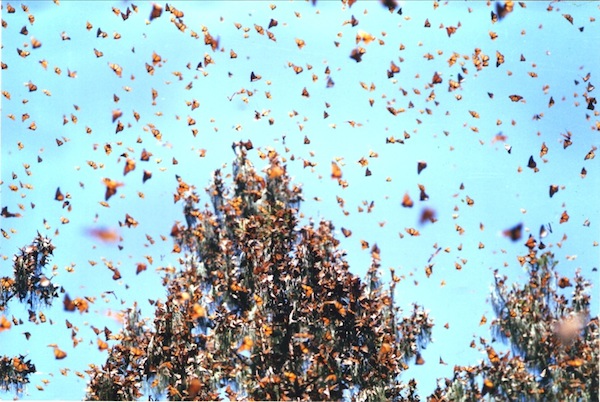
A wintering mass of monarchs. Photo by Raina Kumra.
In response to the monarch’s decline, organizations such as the Center for Biological Diversity, the Center for Food Safety, and the Xerces Society filed a petition with the USFWS seeking protection for the species through the Endangered Species Act.
“We need to take immediate action to protect the monarch so that it doesn’t become another tragic example of a widespread species being erased because we falsely assumed it was too common to become extinct,” said Sarina Jepsen, endangered species director at the Xerces Society. “2014 marks the 100th anniversary of the extinction of the passenger pigeon, which was once so numerous no one would ever have believed it was at risk of extinction. History demonstrates that we cannot afford to be complacent about saving the monarch.”
The petitioning organizations assert the monarch meets the ESA’s definition of a threatened species, and urge that the USFWS list it as such. By doing so, the monarch would be granted more protections such as designation of critical habitat areas. The next step in the process is a “90-day finding” period in which the USFWS decides whether or not the petition merits further review.
According to researchers such as Lincoln Brower, a monarch expert who has studied the species since 1954, the state of monarchs may foretell broader problems, such as declines in other pollinator species that are important for crop and ecosystem health.
“The monarch is the canary in the cornfield,” Brower said, “a harbinger of environmental change that we’ve brought about on such a broad scale that many species of pollinators are now at risk if we don’t take action to protect them.”
Related articles
U.S. citizens willing to spend billions to protect monarch butterflies

(04/03/2014) New research shows Americans are willing to pay for the protection of the ailing monarch butterfly, which is experiencing a steep decline in numbers. The study, published in Conservation Letters, found nearly three-quarters of those surveyed placed importance on conservation efforts for the iconic species.
Scientists discover single gene that enables multiple morphs in a butterfly
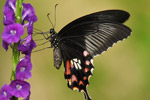
(03/10/2014) Scientists have discovered the gene enabling multiple female morphs that give the Common Mormon butterfly its very tongue-in-cheek name. doublesex, the gene that controls gender in insects, is also a mimicry supergene that determines diverse wing patterns in this butterfly, according to a recent study published in Nature. The study also shows that the supergene is not a cluster of closely-linked genes as postulated for nearly half a century, but a single gene controlling all the variations exhibited by the butterfly’s wings.
Migrating monarch butterflies hit shockingly low numbers
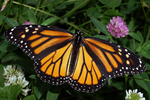
(01/31/2014) The monarch butterfly population overwintering in Mexico this year has hit its lowest numbers ever, according to WWF-Mexico. Monarch butterflies covered just 0.67 hectares in Mexico’s forest, a drop of 44 percent from 2012 already perilously low population. To put this in perspective the average monarch coverage from 1994-2014 was 6.39 or nearly ten times this year’s. For years conservationists feared that deforestation in Mexico would spell the end of the monarch migration, but now scientists say that agricultural and policy changes in the U.S. and Canada—including GMO crops and habitat loss—is strangling off one of the world’s great migrations.
Journalists win environmental news reporting prizes

(12/10/2013) Mongabay’s internship program has benefited from the hard work and great environmental reporting of more than 30 writing interns since the program’s inception in July 2012. This year, Mongabay asked this pool of contributing authors to submit their most compelling piece out of over 150 articles. The submissions were then reviewed by a panel.
Zoo races to save extreme butterfly from extinction
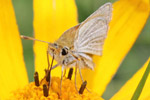
(08/15/2013) In a large room that used to house aquatic mammals at the Minnesota Zoo, Erik Runquist holds up a vial and says, ‘Here are its eggs.’ I peer inside and see small specks, pale with a dot of brown at the top; they look like a single grain of cous cous or quinoa. Runquist explains that the brown on the top is the head cap of the larva, a fact that becomes more clear under a microscope when you can see the encased larva squirm. I’m looking at the eggs of a Poweshiek skipperling, a species that is more imperiled than pandas, tigers, or bluewhales. Once superabundant, only several hundred Poweshiek skipperlings may survive on Earth today and the eggs I’m looking at are the only ones in captivity.
Florida declares two butterfly species extinct as pollinator crisis worsens
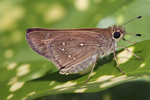
(08/01/2013) Conservationist’s faced a crushing blow last month as two butterfly species native to Florida were declared extinct.
‘Occasionally, these types of butterflies disappear for long periods of time but are rediscovered in another location,’ said Larry Williams, U.S. Fish and Wildlife state supervisor for ecological services. We think it’s apparent now these two species are extinct.’
Habitat loss and pesticides causing decline in Europe’s butterflies
(07/31/2013) Europe’s grassland butterfly population has plummeted in the past two decades, new research published on Tuesday shows, with a near halving in the numbers of key species since 1990.